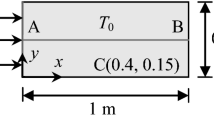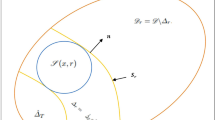Abstract
Youssef introduced two-temperature thermoelasticity without energy dissipation theorem. This theorem depends upon two distinct temperatures: the conductive temperature and the thermo-dynamical temperature. Through this work, the variational principle theorem will be obtained for an isotropic, homogeneous, and thermoelastic body in the context of two-temperature thermoelasticity without energy dissipation theorem.
Similar content being viewed by others
Avoid common mistakes on your manuscript.
1 Introduction
Thermoelasticity without energy dissipation is a novel theory in extended thermoelasticity proposed by Green and Naghdi [1]. The main characteristic of this theory is that the heat flow does not entail energy dissipation, in contrast to the traditional thermoelasticity related to Fourier's equation of heat conduction. The constitutive equation for the entropy flow vector is also determined using the same potential function that was constructed to produce the stress tensor. The theory also allows for the limited-speed transport of heat as thermal waves. The linear theory is then provided once the broad discussion is obtained from the nonlinear theory. Green and Naghdi's broad hypothesis is based on the general entropy balance [2]. While the basic developments in [2] are general, the application is confined to the flow of heat in a stationary rigid solid transmitted by conduction and by the heat pulse propagated as thermal waves at a finite speed. Three types of constitutive response functions are suggested. Type I, after linearization of the theory, is the same as the classical heat conduction theory (based on Fourier’s law), while types II and III permit propagation of thermoelastic disturbances with a finite speed. Although both types II and III theories for heat flow in a stationary rigid solid accommodate finite wave speed, only type II is without energy dissipation [3].
In the context of the Green and Naghdi model, many applications have been found. Chandrasekharaiah and Srinath [4] discussed thermoelastic waves without energy dissipation in an unbounded body with a spherical cavity. Kumar and Deswal [5] studied surface wave propagation in a micropolar thermoelastic medium without energy dissipation. Quintanilla [6] proposed a model of the thermoelastic theory without energy dissipation for materials with affine microstructure. Roychoudhuri and Dutta [7] solved the problem of thermo-elastic interaction without energy dissipation in an infinite solid with distributed periodically varying heat sources. Choudhuri and Bandyopadhyay [7, 8] solved a model of radially symmetric thermo-elastic wave propagation without energy dissipation in an infinitely extended thin plate with a circular hole.
Chen and Gurtin [9], Chen et al. [10] and [11] have formulated a theory of heat conduction in deformable bodies, which depends upon two distinct temperatures, the conductive temperature \(\varphi \,\) and the thermo-dynamical temperature \(T\). For time-independent situations, the difference between these two temperatures is proportional to the heat supply, and in the absence of any heat supply, the two temperatures are identical Chen and Gurtin [9]. However, regardless of the presence of a heat source, the two temperatures are often different for time-dependent issues and wave propagation difficulties in particular. The two temperatures \(T,\,\,\varphi\) and the strain are found to have representations in the form of a travelling wave plus a response, which occurs instantaneously throughout the body [12], and Warren and Chen [13] investigated the wave propagation in the classical theory of two-temperature thermoelasticity while Youssef [14] investigated two-temperature generalized thermoelasticity theory together with a general uniqueness theorem and solved many applications in the context of this theory [15,16,17].
The two-temperature thermoelasticity without energy dissipation theory is obeyed by a homogeneous, isotropic body, and the variational principle theorem will be proven for this body in this study.
1.1 The basic equations
We will consider an isotropic and homogeneous elastic body in the context of two-temperature thermoelasticity without energy dissipation theorem with zero initial conditions of all state functions. Hence, the governing equations will take the following forms [18, 19]:
The equations of motion
The heat equations
The two-temperature equations
The constitutive equations
The entropy satisfies the following relation for unit mass
The entropy balance equations without internal heat generation take the form
The heat conduction equations take the form
Formulation of the variational principle.
Under the assumption of small deviations of the thermo-dynamics system from the state of equilibrium, we will consider the statement of virtual external work:
where v is an arbitrary material volume bounded by a closed and bounded surface s, Fi is the external forces per unit mass and pi is the components of surface traction applied to the surface s.
We have the relation
where ni are the normal components to the surfaces.
Using Eq. (2) and Gauss’s divergence theorem in the second term of the relation (1), we obtain
Since the stress tensor is symmetric, we have \(\sigma_{ji} \,\delta \,e_{ij} = \sigma_{ji} \delta u_{i,j}\).
Using the equation of motion (1), Eq. (3) will take the form
Using Eq. (4), the second term on the right-hand side of Eq. (11) takes the form
We arrive at the theorem of virtual work from Eqs. (8) and (12), we obtain
where
The function W implies the work of the deformation may be expressed by Noda et al. [20] and takes the form
The three terms on the left-hand side of Eq. (13) express the virtual external work of the body forces, tractions on the boundary and inertia forces, respectively, while the right-hand side expresses the virtual internal work.
We introduce an entropy flux H, which is related to the heat flux through the equation
By eliminating the entropy and the heat flux between Eqs. (5), (6) and (16), we get
By eliminating \(q_{i}\) Eqs. (7) and (16), we obtain
Without loss of generality, we can put a parameter for the time derivatives, i.e.
hence, Eq. (18) takes the form
Multiplying by \(\delta H_{i}\) the above equation and integrating over volume v of the body, we get
The second term of the Eq. (20) by using Gauss’s divergence theorem and Eq. (3) reduced to.
which gives
From Eq. (17), we have
Using Eq. (19) and Eq. (22) in the middle term of the right-hand side of Eq. (21), we get
Now, Eq. (20) takes the form
We introduced the heat potential P in the form [20]:
where
and the dissipation function D in the form [20]:
Hence, we get
The dissipation function D which is defined above is a new dissipation function because it contains a new parameter a. If we let a = 0, we get the old dissipation function D that is defined by [20].
Introducing Eqs. (26) and (28) into Eq. (24), we obtain the variational equation for heat conduction
Elimination of the term \(\gamma \,\int\limits_{v} \theta \,\,\delta e_{ii} \,dv\) from Eqs. (13) and (29) leads to
The terms on the right-hand side of Eq. (30) express the virtual external work of the body forces, tractions on the boundary, inertia forces, and heating of the boundary, respectively, while the left-hand side expresses the virtual internal work of deformation, the variation of heat potential, and the variation of the dissipation function, respectively [20].
Introducing the Biot thermoelastic potential \(\phi\)[ 20]:
which gives:
The above equation is the variational principle for the two-temperature thermoelasticity without energy dissipation theory problem.
Availability of data and materials
Not Applicable.
Abbreviations
- \(\lambda \;,\;\mu\) :
-
Lamé’s constants
- \(\rho\) :
-
Density
- \(c_{E}\) :
-
Specific heat at constant strain
- \({\upalpha }_{{\text{T}}}\) :
-
Coefficient of linear thermal expansion
- \(\delta_{ij}\) :
-
The Kronecker delta symbol
- \(t\) :
-
Time
- \(T\) :
-
Temperature
- \(T_{o}\) :
-
Reference temperature
- \(\theta\) :
-
\(= \left( {T - T_{o} } \right)\) Increment temperature such that \(\left| {\frac{\theta }{{\,\,T_{o} }}} \right| < < 1\)
- \(\sigma_{ij}\) :
-
Components of the stress tensor
- \(e_{ij}\) :
-
Components of the strain tensor
- \(u_{i}\) :
-
Components of the displacement vector
- \(F_{i}\) :
-
Body force vector
- \(q_{i}\) :
-
The components of the heat flux
- \(\eta\) :
-
The entropy
- \(k^{*}\) :
-
The characteristic of the theorem
- \(\varphi\) :
-
Conductive temperature
- a:
-
\(a > 0\) Two- temperature parameter
References
Green AE, Naghdi PM (1993) Thermoelasticity without energy dissipation. J Elasticity 31:189–208
Green AE, Naghdi PM (1991) A re-examination of the basic postulate of thermomechanics. Proc Royal Soc New York A432:171–194
Hetnarski RB, Eslami MR (2009) Thermal stresses advanced theory and applications, ISBN 978–1–4020–9246–6. Springer Science Business Media, B.V.
Chandrasekharaiah DS, Srinath KS (2000) thermoelastic waves without energy dissipation in an unbounded body with a spherical cavity. Int J Math Math Sci 23(8):555–562
Kumar R, Deswal S (2002) Surface wave propagation in a micropolar thermoelastic medium without energy dissipation. J Sound vibration 256(1):173–178
Quintanilla R (2002) Thermoelasticity without energy dissipation of materials with microstructure. J Appl Math Model 26:1125–1137
Roychoudhuri SK, Bandyopadhyay N (2006) Radially symmetric thermo-elastic wave propagation without energy dissipation in an infinitely extended thin plate with a circular hole. J Appl Math Comp 179(1):267–281
Roychoudhuri SK, Dutta PS (2005) Thermo-elastic interaction without energy dissipation in an infinite solid with distributed periodically varying heat sources. Int J Solids Struct 42:4192–4203
Chen PJ, Gurtin ME (1968) On a theory of heat conduction involving two temperatures. ZAMP 19:614–627
Chen PJ, Gurtin ME, Williams WO (1968) a note on non-simple heat conduction. ZAMP 19:969–970
Chen PJ, Gurtin ME, Williams WO (1969) On The Thermodynamics of non-simple elastic materials with two temperatures. ZAMP 20:107–112
Boley BA, Tolins IS (1962) Transient coupled thermoelastic boundary value problems in the half-space. J App Mech 29:637–646
Warren WE, Chen PJ (1973) Wave propagation in the two-temperature theory of thermoelasticity. J Acta Mechanica 16:21–33
Youssef HM (2006) Theory of two-temperature generalized thermoelasticity. IMA J App Math 71(3):383–390
Youssef HM, Al-Lehaibi EA (2007) State-space approach of two temperature generalized thermoelasticity of one-dimensional problem. Int J Solid Structure 44:1550–1562
Youssef HM, Al-Harby AH (2007) State-space approach of two-temperature generalized thermoelasticity of infinite body with a spherical cavity subjected to different types of thermal loading. J Archive of Appl Mech 77(9):675–687
Youssef HM (2008) Two-dimensional problem of two-temperature generalized thermoelastic half-space subjected to ramp-type heating. J Comp Math Model 19(2):201–216
Youssef HM (2011) Theory of two-temperature thermoelasticity without energy dissipation. J Thermal Stresses 34(2):138–146
Lotfy K, Tantawi RS (2020) Photo-thermal-elastic interaction in a functionally graded material (fgm) and magnetic field. SILICON 12(2):295–303
Naotak N, Hetnarski R, Tanigawa Y (2003) Thermal Stresses, 2nd edn. Taylor & Francis, New York
Funding
Not Applicable.
Author information
Authors and Affiliations
Contributions
Not Applicable.
Corresponding author
Ethics declarations
Conflict of interests
Not Applicable.
Additional information
Publisher’s Note
Springer Nature remains neutral with regard to jurisdictional claims in published maps and institutional affiliations.
Rights and permissions
Open Access This article is licensed under a Creative Commons Attribution 4.0 International License, which permits use, sharing, adaptation, distribution and reproduction in any medium or format, as long as you give appropriate credit to the original author(s) and the source, provide a link to the Creative Commons licence, and indicate if changes were made. The images or other third party material in this article are included in the article's Creative Commons licence, unless indicated otherwise in a credit line to the material. If material is not included in the article's Creative Commons licence and your intended use is not permitted by statutory regulation or exceeds the permitted use, you will need to obtain permission directly from the copyright holder. To view a copy of this licence, visit http://creativecommons.org/licenses/by/4.0/.
About this article
Cite this article
Al-Lehaibi, E.A.N. The variationally principle of two-temperature thermoelasticity in the absence of the energy dissipation theorem. J. Umm Al-Qura Univ. Eng.Archit. 13, 81–85 (2022). https://doi.org/10.1007/s43995-022-00003-z
Received:
Accepted:
Published:
Issue Date:
DOI: https://doi.org/10.1007/s43995-022-00003-z




